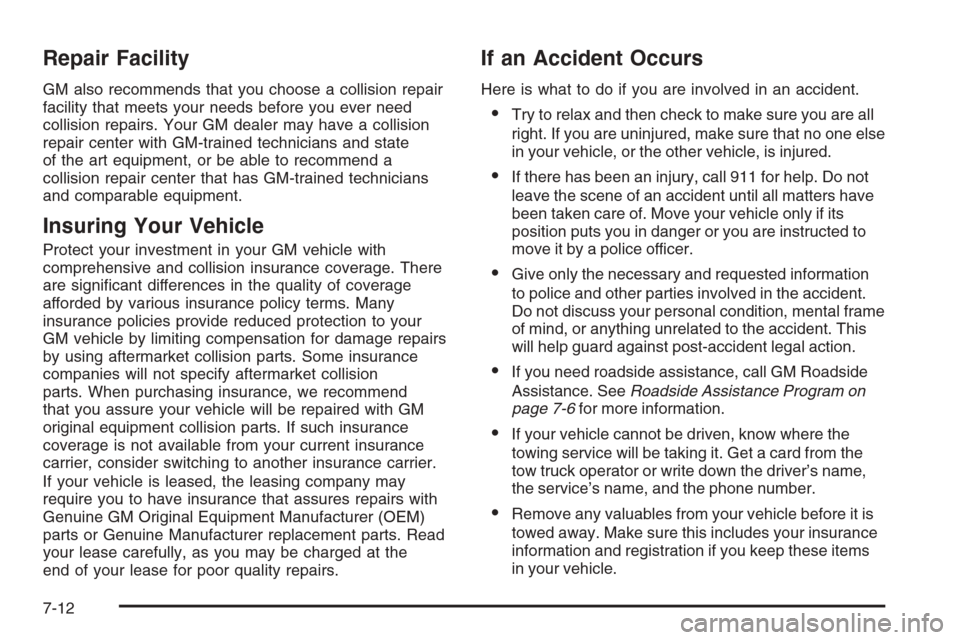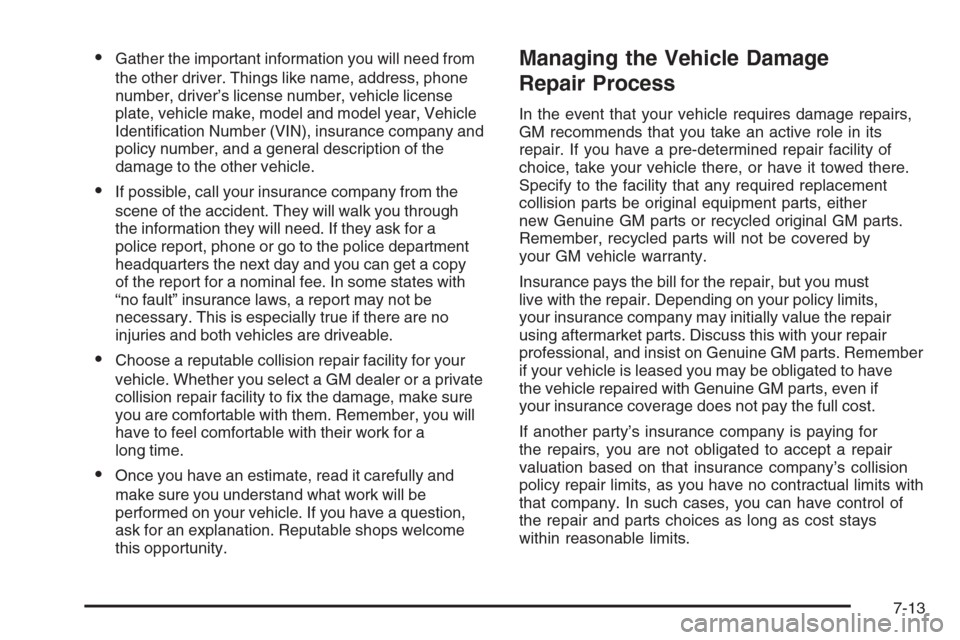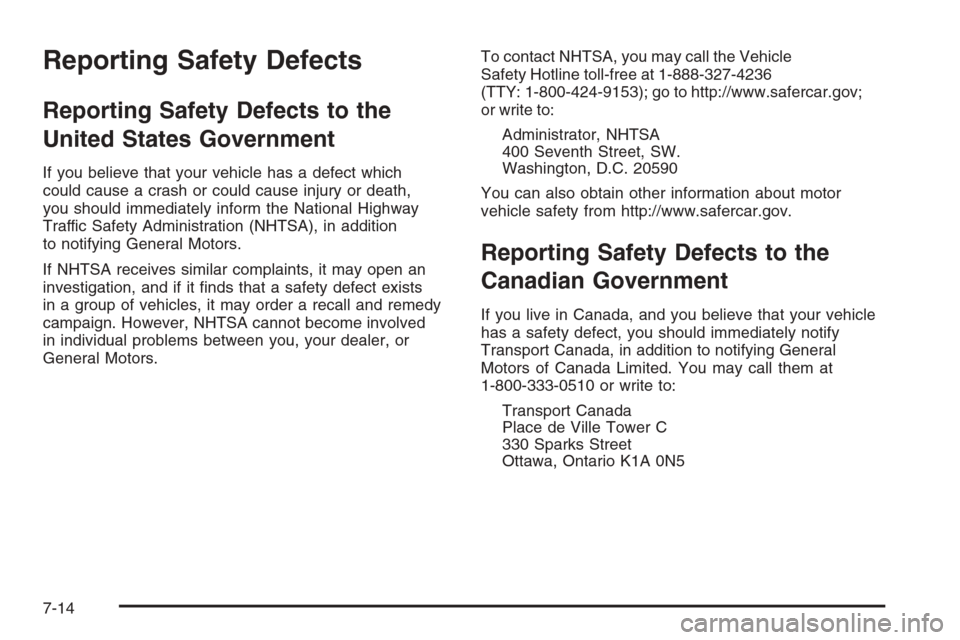2006 CHEVROLET TAHOE tow
[x] Cancel search: towPage 520 of 540

Repair Facility
GM also recommends that you choose a collision repair
facility that meets your needs before you ever need
collision repairs. Your GM dealer may have a collision
repair center with GM-trained technicians and state
of the art equipment, or be able to recommend a
collision repair center that has GM-trained technicians
and comparable equipment.
Insuring Your Vehicle
Protect your investment in your GM vehicle with
comprehensive and collision insurance coverage. There
are signi�cant differences in the quality of coverage
afforded by various insurance policy terms. Many
insurance policies provide reduced protection to your
GM vehicle by limiting compensation for damage repairs
by using aftermarket collision parts. Some insurance
companies will not specify aftermarket collision
parts. When purchasing insurance, we recommend
that you assure your vehicle will be repaired with GM
original equipment collision parts. If such insurance
coverage is not available from your current insurance
carrier, consider switching to another insurance carrier.
If your vehicle is leased, the leasing company may
require you to have insurance that assures repairs with
Genuine GM Original Equipment Manufacturer (OEM)
parts or Genuine Manufacturer replacement parts. Read
your lease carefully, as you may be charged at the
end of your lease for poor quality repairs.
If an Accident Occurs
Here is what to do if you are involved in an accident.
Try to relax and then check to make sure you are all
right. If you are uninjured, make sure that no one else
in your vehicle, or the other vehicle, is injured.
If there has been an injury, call 911 for help. Do not
leave the scene of an accident until all matters have
been taken care of. Move your vehicle only if its
position puts you in danger or you are instructed to
move it by a police officer.
Give only the necessary and requested information
to police and other parties involved in the accident.
Do not discuss your personal condition, mental frame
of mind, or anything unrelated to the accident. This
will help guard against post-accident legal action.
If you need roadside assistance, call GM Roadside
Assistance. SeeRoadside Assistance Program on
page 7-6for more information.
If your vehicle cannot be driven, know where the
towing service will be taking it. Get a card from the
tow truck operator or write down the driver’s name,
the service’s name, and the phone number.
Remove any valuables from your vehicle before it is
towed away. Make sure this includes your insurance
information and registration if you keep these items
in your vehicle.
7-12
Page 521 of 540

Gather the important information you will need from
the other driver. Things like name, address, phone
number, driver’s license number, vehicle license
plate, vehicle make, model and model year, Vehicle
Identi�cation Number (VIN), insurance company and
policy number, and a general description of the
damage to the other vehicle.
If possible, call your insurance company from the
scene of the accident. They will walk you through
the information they will need. If they ask for a
police report, phone or go to the police department
headquarters the next day and you can get a copy
of the report for a nominal fee. In some states with
“no fault” insurance laws, a report may not be
necessary. This is especially true if there are no
injuries and both vehicles are driveable.
Choose a reputable collision repair facility for your
vehicle. Whether you select a GM dealer or a private
collision repair facility to �x the damage, make sure
you are comfortable with them. Remember, you will
have to feel comfortable with their work for a
long time.
Once you have an estimate, read it carefully and
make sure you understand what work will be
performed on your vehicle. If you have a question,
ask for an explanation. Reputable shops welcome
this opportunity.
Managing the Vehicle Damage
Repair Process
In the event that your vehicle requires damage repairs,
GM recommends that you take an active role in its
repair. If you have a pre-determined repair facility of
choice, take your vehicle there, or have it towed there.
Specify to the facility that any required replacement
collision parts be original equipment parts, either
new Genuine GM parts or recycled original GM parts.
Remember, recycled parts will not be covered by
your GM vehicle warranty.
Insurance pays the bill for the repair, but you must
live with the repair. Depending on your policy limits,
your insurance company may initially value the repair
using aftermarket parts. Discuss this with your repair
professional, and insist on Genuine GM parts. Remember
if your vehicle is leased you may be obligated to have
the vehicle repaired with Genuine GM parts, even if
your insurance coverage does not pay the full cost.
If another party’s insurance company is paying for
the repairs, you are not obligated to accept a repair
valuation based on that insurance company’s collision
policy repair limits, as you have no contractual limits with
that company. In such cases, you can have control of
the repair and parts choices as long as cost stays
within reasonable limits.
7-13
Page 522 of 540

Reporting Safety Defects
Reporting Safety Defects to the
United States Government
If you believe that your vehicle has a defect which
could cause a crash or could cause injury or death,
you should immediately inform the National Highway
Traffic Safety Administration (NHTSA), in addition
to notifying General Motors.
If NHTSA receives similar complaints, it may open an
investigation, and if it �nds that a safety defect exists
in a group of vehicles, it may order a recall and remedy
campaign. However, NHTSA cannot become involved
in individual problems between you, your dealer, or
General Motors.To contact NHTSA, you may call the Vehicle
Safety Hotline toll-free at 1-888-327-4236
(TTY: 1-800-424-9153); go to http://www.safercar.gov;
or write to:
Administrator, NHTSA
400 Seventh Street, SW.
Washington, D.C. 20590
You can also obtain other information about motor
vehicle safety from http://www.safercar.gov.
Reporting Safety Defects to the
Canadian Government
If you live in Canada, and you believe that your vehicle
has a safety defect, you should immediately notify
Transport Canada, in addition to notifying General
Motors of Canada Limited. You may call them at
1-800-333-0510 or write to:
Transport Canada
Place de Ville Tower C
330 Sparks Street
Ottawa, Ontario K1A 0N5
7-14
Page 533 of 540

Light (cont.)
Low Fuel Warning.......................................3-50
Malfunction Indicator....................................3-45
Passenger Airbag Status Indicator..................3-37
Safety Belt Reminder...................................3-36
Security.....................................................3-49
Tire Pressure..............................................3-44
Tow/Haul Mode ...........................................3-50
Lighting
Entry.........................................................3-19
Exit ...........................................................3-19
Loading Your Vehicle.......................................4-48
Locking Rear Axle............................................ 4-8
Lockout Protection..........................................2-13
Locks
Delayed Locking..........................................2-10
Door ........................................................... 2-8
Lockout Protection.......................................2-13
Power Door .................................................. 2-9
Programmable Automatic Door Locks.............2-10
Rear Door Security Locks.............................2-12
Loss of Control...............................................4-16
Low Fuel Warning Light...................................3-50
Luggage Carrier..............................................2-56
Lumbar
Power Controls............................................. 1-3M
Maintenance Schedule
Additional Required Services........................... 6-6
At Each Fuel Fill........................................... 6-9
At Least Once a Month................................6-10
At Least Once a Year..................................6-10
Introduction.................................................. 6-2
Maintenance Footnotes.................................. 6-7
Maintenance Record....................................6-16
Maintenance Requirements............................. 6-2
Normal Maintenance Replacement Parts.........6-14
Owner Checks and Services........................... 6-9
Recommended Fluids and Lubricants.............6-12
Scheduled Maintenance................................. 6-4
Using.......................................................... 6-2
Your Vehicle and the Environment................... 6-2
Malfunction Indicator Light................................3-45
Manual Seats................................................... 1-2
Memory Seat.................................................2-61
Message
DIC Warnings and Messages........................3-55
Mirrors
Automatic Dimming Rearview with Compass....2-42
Automatic Dimming Rearview with Compass
and Temperature Display...........................2-43
9
Page 536 of 540

Rear Air Conditioning and Heating System.........3-31
Rear Air Conditioning and Heating System
and Electronic Climate Controls.....................3-32
Rear Axle......................................................5-47
Locking........................................................ 4-8
Rear Door Security Locks................................2-12
Rear Outside Passenger Positions,
Safety Belts................................................1-43
Rear Safety Belt Comfort Guides......................1-45
Rear Seat Audio (RSA)..................................3-128
Rear Seat Entertainment System.....................3-117
Rear Seat Operation......................................... 1-9
Rear Storage Area..........................................2-57
Rear Windshield Washer/Wiper.........................3-10
Rearview Mirror, Automatic Dimming with
Compass....................................................2-42
Rearview Mirror, Automatic Dimming with
Compass and Temperature Display................2-43
Rearview Mirror, Automatic Dimming with
OnStar
®and Compass.................................2-37
Rearview Mirror, Automatic Dimming with
OnStar
®, Compass and Temperature Display.....2-39
Rearview Mirrors.............................................2-37
Reclining Seatbacks.......................................... 1-5Recommended Fluids and Lubricants.................6-12
Recovery Hooks.............................................4-47
Recreational Vehicle Towing.............................4-58
Remote Keyless Entry System............................ 2-4
Remote Keyless Entry System, Operation............ 2-5
Removing the Flat Tire and Installing the
Spare Tire..................................................5-84
Removing the Spare Tire and Tools...................5-80
Replacement Bulbs.........................................5-57
Reporting Safety Defects
Canadian Government..................................7-14
General Motors...........................................7-15
United States Government............................7-14
Restraint System Check
Checking the Restraint Systems....................1-87
Replacing Restraint System Parts
After a Crash..........................................1-88
Retained Accessory Power (RAP)......................2-20
Right Front Passenger Position, Safety Belts......1-41
Roadside
Assistance Program....................................... 7-6
Rocking Your Vehicle to Get it Out....................4-46
Routing, Engine Drive Belt...............................6-15
Running the Engine While Parked.....................2-36
12
Page 539 of 540

Tires (cont.)
Spare Tire..................................................5-99
Storing a Flat or Spare Tire and Tools............5-94
Tire Sidewall Labeling..................................5-60
Tire Terminology and De�nitions....................5-63
Uniform Tire Quality Grading.........................5-74
Wheel Alignment and Tire Balance.................5-75
Wheel Replacement.....................................5-75
When It Is Time for New Tires......................5-71
Tow/Haul Mode ...............................................2-26
Tow/Haul Mode Light.......................................3-50
Towing
Recreational Vehicle.....................................4-58
Towing a Trailer..........................................4-62
Your Vehicle...............................................4-58
Traction
StabiliTrak
®System....................................... 4-9
Trailer
Recommendations.......................................4-79
Transmission
Fluid, Automatic...........................................5-22
Temperature Gage.......................................3-43
Transmission Operation, Automatic....................2-23
Trip Odometer................................................3-36
Turn and Lane-Change Signals.......................... 3-7
Turn Signal/Multifunction Lever........................... 3-7
U
Understanding Radio Reception.......................3-131
Uniform Tire Quality Grading............................5-74
Universal Home Remote System.......................2-52
Operation...................................................2-52
V
Vehicle
Control........................................................ 4-5
Damage Warnings........................................... iv
Loading......................................................4-48
Symbols......................................................... iv
Vehicle Customization, DIC..............................3-66
Vehicle Data Collection and Event Data
Recorders..................................................7-10
Vehicle Identi�cation
Number (VIN)............................................5-108
Service Parts Identi�cation Label..................5-108
Vehicle Personalization....................................2-60
Memory Seat..............................................2-61
Ventilation Adjustment......................................3-30
Visors...........................................................2-16
Voltmeter Gage..............................................3-40
15